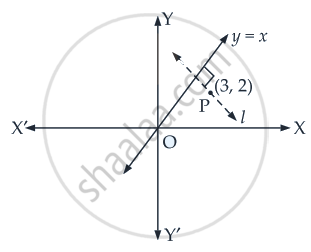Advertisements
Advertisements
Question
The equation of the straight line passing through the point (3, 2) and perpendicular to the line y = x is ______.
Options
x – y = 5
x + y = 5
x + y = 1
x – y = 1
Solution
The equation of the straight line passing through the point (3, 2) and perpendicular to the line y = x is x + y = 5.
Explanation:

Equation of line ‘l’ is given by y – y1 = m(x – x1).
Since l passing through the point P(3, 2).
∴ y – 2 = m(x – 3)
⇒ y = mx + 2 – 3m .....(i)
Since it is given that lines y = x
And ‘l’ are perpendicular to each other
∴ `"m" xx1`= –1 .....`[because "m"_1 xx "m"_2 = - 1]`
m = –1
Put m = – 1 in eqn. (i), we get
y = –x + 2 – 3(–1)
y = –x + 5
x + y = 5
APPEARS IN
RELATED QUESTIONS
Find the slope of a line, which passes through the origin, and the mid-point of the line segment joining the points P (0, –4) and B (8, 0).
If three point (h, 0), (a, b) and (0, k) lie on a line, show that `q/h + b/k = 1`
Consider the given population and year graph. Find the slope of the line AB and using it, find what will be the population in the year 2010?

Find the value of p so that the three lines 3x + y – 2 = 0, px + 2y – 3 = 0 and 2x – y – 3 = 0 may intersect at one point.
Find the slope of the lines which make the following angle with the positive direction of x-axis:
\[\frac{3\pi}{4}\]
State whether the two lines in each of the following is parallel, perpendicular or neither.
Through (6, 3) and (1, 1); through (−2, 5) and (2, −5)
What can be said regarding a line if its slope is zero ?
Show that the line joining (2, −3) and (−5, 1) is parallel to the line joining (7, −1) and (0, 3).
Show that the line joining (2, −5) and (−2, 5) is perpendicular to the line joining (6, 3) and (1, 1).
Consider the following population and year graph:
Find the slope of the line AB and using it, find what will be the population in the year 2010.

By using the concept of slope, show that the points (−2, −1), (4, 0), (3, 3) and (−3, 2) are the vertices of a parallelogram.
A quadrilateral has vertices (4, 1), (1, 7), (−6, 0) and (−1, −9). Show that the mid-points of the sides of this quadrilateral form a parallelogram.
Find the equation of a straight line with slope 2 and y-intercept 3 .
Find the angles between the following pair of straight lines:
x − 4y = 3 and 6x − y = 11
The acute angle between the medians drawn from the acute angles of a right angled isosceles triangle is
The medians AD and BE of a triangle with vertices A (0, b), B (0, 0) and C (a, 0) are perpendicular to each other, if
If the slopes of the lines given by the equation ax2 + 2hxy + by2 = 0 are in the ratio 5 : 3, then the ratio h2 : ab = ______.
Point of the curve y2 = 3(x – 2) at which the normal is parallel to the line 2y + 4x + 5 = 0 is ______.
The line passing through (– 2, 0) and (1, 3) makes an angle of ______ with X-axis.
If the slope of a line passing through the point A(3, 2) is `3/4`, then find points on the line which are 5 units away from the point A.
If p is the length of perpendicular from the origin on the line `x/a + y/b` = 1 and a2, p2, b2 are in A.P, then show that a4 + b4 = 0.
Slope of a line which cuts off intercepts of equal lengths on the axes is ______.
The tangent of angle between the lines whose intercepts on the axes are a, – b and b, – a, respectively, is ______.
The coordinates of the foot of perpendiculars from the point (2, 3) on the line y = 3x + 4 is given by ______.
The points A(– 2, 1), B(0, 5), C(– 1, 2) are collinear.
The line `x/a + y/b` = 1 moves in such a way that `1/a^2 + 1/b^2 = 1/c^2`, where c is a constant. The locus of the foot of the perpendicular from the origin on the given line is x2 + y2 = c2.
Line joining the points (3, – 4) and (– 2, 6) is perpendicular to the line joining the points (–3, 6) and (9, –18).
The line which passes through the origin and intersect the two lines `(x - 1)/2 = (y + 3)/4 = (z - 5)/3, (x - 4)/2 = (y + 3)/3 = (z - 14)/4`, is ______.
